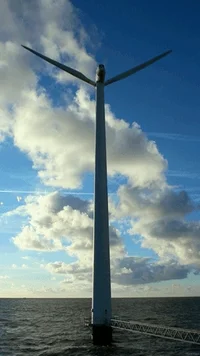Fishermen survey finds varied perceptions of impacts of Block Island Wind Farm
 Commercial fishermen have very
different perceptions of the impact of the Block Island Wind Farm than do
recreational fishermen, according to a survey of both groups by a University of
Rhode Island doctoral student.
Commercial fishermen have very
different perceptions of the impact of the Block Island Wind Farm than do
recreational fishermen, according to a survey of both groups by a University of
Rhode Island doctoral student.
Of the 25 fishermen interviewed, all
of whom said they regularly fish in the area of the wind farm, the recreational
fishermen generally perceive the turbines positively while the commercial
fishermen see them as mostly negative.
The results of the study, funded by
Rhode Island Sea Grant, were reported at a meeting of the American Geophysical
Union in Washington, D.C., in December.
“Little is known about the impacts
of offshore wind farms on marine users in the United States, and it’s critical
to understand these impacts in context,” said Tayla ten Brink, the URI student
who conducted the survey with Professor Tracey Dalton.
“Generally, our findings show there are uneven impacts on the different fishing sectors.”
“Generally, our findings show there are uneven impacts on the different fishing sectors.”
According to ten Brink, almost all
of the fishermen agreed that there is more recreational fishing taking place in
the vicinity of the wind turbines than before the turbines were installed.
That’s because the turbine support structures serve as artificial reefs that attract a wide variety of fish and marine invertebrates to the area. Cod and other species not found in the area before are now observed, for instance.
That’s because the turbine support structures serve as artificial reefs that attract a wide variety of fish and marine invertebrates to the area. Cod and other species not found in the area before are now observed, for instance.
As a result, charter boats and recreational fishermen are drawn to the area that they seldom visited prior to the wind farm installation. The wind farm has also become a prime destination for recreational spearfishing.
The commercial fishermen surveyed
said that the increase in recreational fishermen – as well as what they called
“wind farm tourists” – were an inconvenience because they increased activity on
their fishing ground.
The commercial fishermen also noted
fears that their gill nets and other gear would become entangled in the
recreational fishermen’s gear, forcing them to be more cautious about where
they fish. They also worry about running into the turbines with their vessels.
The end result, they said, is fewer places for them to conduct their business.
The survey results could have
implications for future planning for wind farm development.
“Climate change is a huge problem worldwide, and renewable energy resources could reduce CO2 emissions by half, so if we’re planning on using offshore wind, it’s important to understand the concerns and the pros and cons of the structures being out there,” said ten Brink.
“Once we understand, it will be much easier to have a productive discussion about how to go forward with offshore wind development.
“As with any large-scale project,
offshore wind development can be done right or wrong,” she added.
“These results inform how it can be done right, with minimal negative impact and maximum positive impact.”
“These results inform how it can be done right, with minimal negative impact and maximum positive impact.”
ten Brink suggested that the survey
results might inspire wind farm developers to build relationships with charter
boats and recreational fishing organizations that would benefit from offshore
wind farm installations. Developers might also ease the concerns expressed by
commercial fishermen about running into the structures by supporting the
acquisition of new navigation equipment for the fishermen.
“The survey results open up a lot of
ways to create win-win situations,” she said.
ten Brink cautioned, however, that
her results only reflect the impacts of one small wind farm in operation for
only one year. Once the novelty wears off for the recreational fishermen and
the commercial fishermen learn to live with the turbines, their perceptions may
change.
“There were fishermen who were
really worried about the impacts and were pleased when the impacts weren’t too
bad, but they’re still worried about the impacts of more and more turbines in
the future,” ten Brink concluded.